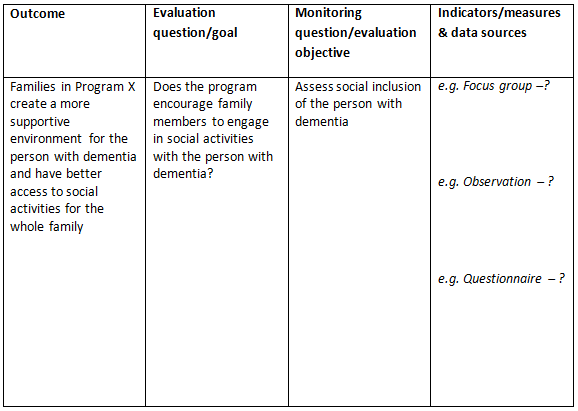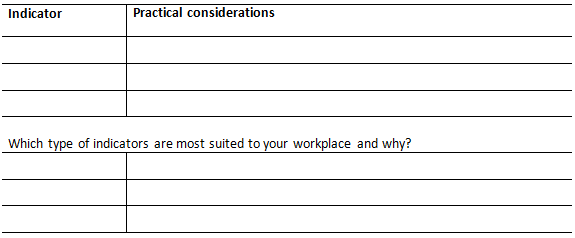ACTIVITY 4: IDENTIFYING INDICATORS AND DATA SOURCES
Case Study: Grandfriends Program
Program X is aimed at identifying and providing suitable activities for people with dementia and their families to participate in. In particular, Program X wants young grandchildren who may not understand dementia to be able to maintain their connection with their grandparent. Program X believes they can strengthen family bonds and encourage adult children and other family members to continue meaningful interactions with the person with dementia. This will result in a better environment for the person with dementia and their family.
Part 1
Below is a partly filled out table for Program X. Try to develop your own evaluation goals and objectives and identify indicators and data sources based on the information in the table.
Program X is aimed at identifying and providing suitable activities for people with dementia and their families to participate in. In particular, Program X wants young grandchildren who may not understand dementia to be able to maintain their connection with their grandparent. Program X believes they can strengthen family bonds and encourage adult children and other family members to continue meaningful interactions with the person with dementia. This will result in a better environment for the person with dementia and their family.
Part 1
Below is a partly filled out table for Program X. Try to develop your own evaluation goals and objectives and identify indicators and data sources based on the information in the table.
Part 2
For the indicators you have written down in Part 1, can you identify any practical issues associated with obtaining that information? Also, how would you address these practical issues in your own workplace?
Things to consider:
You can summarise the indicators and practical issues identified in a table similar to the one below.
For the indicators you have written down in Part 1, can you identify any practical issues associated with obtaining that information? Also, how would you address these practical issues in your own workplace?
Things to consider:
- Do any of your measures require expertise (e.g., it involves a scale that can only be administered by a clinician)?
- How many people (e.g., clients/staff members) are needed to conduct the evaluation?
- Are there any logistics issues (e.g., home visits, computer access)?
- Do you foresee any ethical issues (e.g., ability to consent)?
You can summarise the indicators and practical issues identified in a table similar to the one below.


